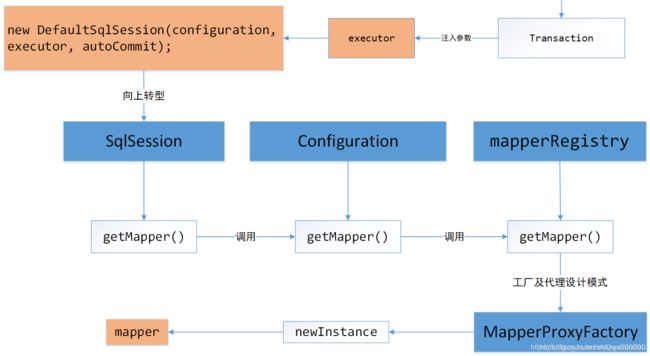解释MyBatis主要语句源码流程图
对于mybatis 来讲 整体的流程大体为下图
InputStream is = Resources.getResourceAsStream("mybatis-config.xml");
SqlSessionFactory factory = new SqlSessionFactoryBuilder().build(is);
SqlSession sqlSession = factory.openSession();
UserMapper mapper = sqlSession.getMapper(UserMapper.class);
一、获取配置文件的文件输入流
InputStream is = Resources.getResourceAsStream("mybatis-config.xml");
Resource 资源工具类
作用 : 将路径下的资源文件读取到流中
首先通过getResourceAsStream 读取资源文件
class:Resources
public static InputStream getResourceAsStream(String resource) throws IOException {
return getResourceAsStream(null, resource);
}
/*
* Returns a resource on the classpath as a Stream object
*
* @param loader The classloader used to fetch the resource
* @param resource The resource to find
* @return The resource
* @throws java.io.IOException If the resource cannot be found or read
*/
public static InputStream getResourceAsStream(ClassLoader loader, String resource) throws IOException {
InputStream in = classLoaderWrapper.getResourceAsStream(resource, loader);
if (in == null) {
throw new IOException("Could not find resource " + resource);
}
return in;
}
在读取的过程中第哦啊用classLoaderWapper中的方法
class : ClassLoaderWrapper
/*
* Returns a resource on the classpath as a Stream object
*
* @param resource The resource to find
* @return The resource
* @throws java.io.IOException If the resource cannot be found or read
*/
public static InputStream getResourceAsStream(String resource) throws IOException {
return getResourceAsStream(null, resource);
}
/*
* Returns a resource on the classpath as a Stream object
*
* @param loader The classloader used to fetch the resource
* @param resource The resource to find
* @return The resource
* @throws java.io.IOException If the resource cannot be found or read
*/
public static InputStream getResourceAsStream(ClassLoader loader, String resource) throws IOException {
InputStream in = classLoaderWrapper.getResourceAsStream(resource, loader);
if (in == null) {
throw new IOException("Could not find resource " + resource);
}
return in;
}
/*
* Get a resource from the classpath, starting with a specific class loader
*
* @param resource - the resource to find
* @param classLoader - the first class loader to try
* @return the stream or null
*/
public InputStream getResourceAsStream(String resource, ClassLoader classLoader) {
return getResourceAsStream(resource, getClassLoaders(classLoader));
}
对传进的classLoder[ ] 这个类加载器的数组进行遍历 类判断类加载其中的流是否为null
如果不为空 则返回一个InputStream 输入流对象
class: ClassLoaderWrapper
/*
* Try to get a resource from a group of classloaders
*
* @param resource - the resource to get
* @param classLoader - the classloaders to examine
* @return the resource or null
*/
InputStream getResourceAsStream(String resource, ClassLoader[] classLoader) {
for (ClassLoader cl : classLoader) {
if (null != cl) {
// try to find the resource as passed
InputStream returnValue = cl.getResourceAsStream(resource);
// now, some class loaders want this leading "/", so we'll add it and try again if we didn't find the resource
if (null == returnValue) {
returnValue = cl.getResourceAsStream("/" + resource);
}
if (null != returnValue) {
return returnValue;
}
}
}
return null;
}
获取SqlsessionFactory
SqlSessionFactory factory = new SqlSessionFactoryBuilder().build(is);
**SqlsessionFactory是mybatis的 核心对象,获取核心对象的方式
SqlsessionFactoryBuilder构建 SqlsessionFactory 实例
通过Xpath解析的方式去解析mybatis-config.xml 文件 解析的文件内容套接到configuration中 而这个configuration 相当于 mybatis-config.xml 中的配置文件所对应的类。返回DefaultSqlSessionFactory对象。
**
构建SqlSessionFactory示例
public SqlSessionFactory build(InputStream inputStream) {
return build(inputStream, null, null);
}
通过Xpath解析的方式去解析mybatis-config.xml 文件 解析的文件内容套接到configuration中 而这个configuration 相当于 mybatis-config.xml 中的配置文件所对应的类。返回DefaultSqlSessionFactory对象
public SqlSessionFactory build(InputStream inputStream, String environment, Properties properties) {
try {
XMLConfigBuilder parser = new XMLConfigBuilder(inputStream, environment, properties);
return build(parser.parse());
} catch (Exception e) {
throw ExceptionFactory.wrapException("Error building SqlSession.", e);
} finally {
ErrorContext.instance().reset();
try {
inputStream.close();
} catch (IOException e) {
// Intentionally ignore. Prefer previous error.
}
}
}
public SqlSessionFactory build(Configuration config) {
return new DefaultSqlSessionFactory(config);
}
三、获取SqlSession对象
**获取SQLsession对象 通过DefaultSqlSessionFactory对象调用它里面opensession方法返回DefaultSQLSession对象
调用的是DefaultSqlSessionFactory类中opensessionFromDataSource
该方法下有三个参数 第一个执行器的类型 第二个 事务的隔离级别 第三个 是否自动提交
**
*
流程

获取SQLsession对象 通过DefaultSqlSessionFactory对象调用它里面opensession方法返回DefaultSQLSession对象
@Override
public SqlSession openSession(ExecutorType execType, TransactionIsolationLevel level) {
return openSessionFromDataSource(execType, level, false);
}
private SqlSession openSessionFromDataSource(ExecutorType execType, TransactionIsolationLevel level, boolean autoCommit) {
//*声明一个事务的对象
Transaction tx = null;
try {
//通过配置文件去读取环境标签的信息
final Environment environment = configuration.getEnvironment();
final TransactionFactory transactionFactory = getTransactionFactoryFromEnvironment(environment);
//通过dataSource的配置获取事务的对象
tx = transactionFactory.newTransaction(environment.getDataSource(), level, autoCommit);
//,再根据事务执行器的类型 去创建事务执行器 Executor(相当于Statement)通过执行器
final Executor executor = configuration.newExecutor(tx, execType);
//事务自动提交以及配置文件对象 返回 DefaultSqlSession对象。
return new DefaultSqlSession(configuration, executor, autoCommit);
} catch (Exception e) {
closeTransaction(tx); // may have fetched a connection so lets call close()
throw ExceptionFactory.wrapException("Error opening session. Cause: " + e, e);
} finally {
ErrorContext.instance().reset();
}
}
四、通过sqlsession获取相应Mapper
**第一层通过调用sqlsession中getMapper方法
第二层通过调用配置中的getMapper方法
第三层通过映射的注册器中的getMapper方法来进行获取相应的Mapper对象
其中使用了MapperProxyFactory 工厂对象来获取 MapperProxy 在里面使用反射和动态代理的方式来获取最终的mapper对象。
**
@Override
public <T> T getMapper(Class<T> type) {
return getConfiguration().getMapper(type, this);
}
通过调用配置中的getMapper方法
public <T> T getMapper(Class<T> type, SqlSession sqlSession) {
return mapperRegistry.getMapper(type, sqlSession);
}
通过映射的注册器中的getMapper方法来进行获取相应的Mapper对象
public <T> T getMapper(Class<T> type, SqlSession sqlSession) {
final MapperProxyFactory<T> mapperProxyFactory = (MapperProxyFactory<T>) knownMappers.get(type);
if (mapperProxyFactory == null) {
throw new BindingException("Type " + type + " is not known to the MapperRegistry.");
}
try {
return mapperProxyFactory.newInstance(sqlSession);
} catch (Exception e) {
throw new BindingException("Error getting mapper instance. Cause: " + e, e);
}
}
MapperProxyFactory 工厂对象来获取 MapperProxy 在里面使用反射和动态代理的方式来获取最终的mapper对象。
public T newInstance(SqlSession sqlSession) {
final MapperProxy<T> mapperProxy = new MapperProxy<>(sqlSession, mapperInterface, methodCache);
return newInstance(mapperProxy);
}
总结
一、通过getResourceAsStream 读取资源文件
在读取的过程中 调用 classLoaderWrapper中的方法
然后通过对classLoader[]数组的遍历 然后进行判断 类加载器中所读的流是否为null
如果不为null 则返回InputStream对象
二、
SqlsessionFactory是mybatis的 核心对象,获取核心对象的方式
SqlsessionFactoryBuilder构建 SqlsessionFactory 实例
通过Xpath解析的方式去解析mybatis-config.xml 文件 解析的文件内容套接到configuration中 而这个configuration 相当于 mybatis-config.xml 中的配置文件所对应的类。返回DefaultSqlSessionFactory对象。
三、
获取SQLsession对象 通过DefaultSqlSessionFactory对象调用它里面opensession方法返回DefaultSQLSession对象
调用的是DefaultSqlSessionFactory类中opensessionFromDataSource
四、通过sqlsession获取相应Mapper
第一层通过调用sqlsession中getMapper方法
第二层通过调用配置中的getMapper方法
第三层通过映射的注册器中的getMapper方法来进行获取相应的Mapper对象
其中使用了MapperProxyFactory 工厂对象来获取 MapperProxy 在里面使用反射和动态代理的方式来获取最终的mapper对象。



